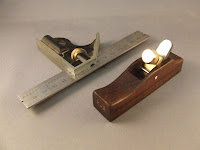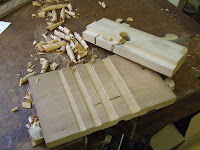
Hi Folks
Working on a Moving Fillister for a customer at the moment. African Blackwood was the timber choice (after seeing my Blackwood Skew Miter at WIA). I love the look of Blackwood - stunning figure and that "almost Ebony" colour. But it is seriously tough to work with. I reminds me more of stone than wood, chipping away bit by bit. And the weight - well, it's almost as dense as stone. Quite a shock the first time you pick a piece up ;)
But the plane is progressing well - spent yesterday making the metalwork. There's a fair bit involved, too - two blades, brass depth stop, depth stop cover and knurled brass knob. And the fence bolts and washers. Just got some wedge fitting left to do and then I can start polishing the beasty up - I think its going to be something special :)
Cheers
Philly










